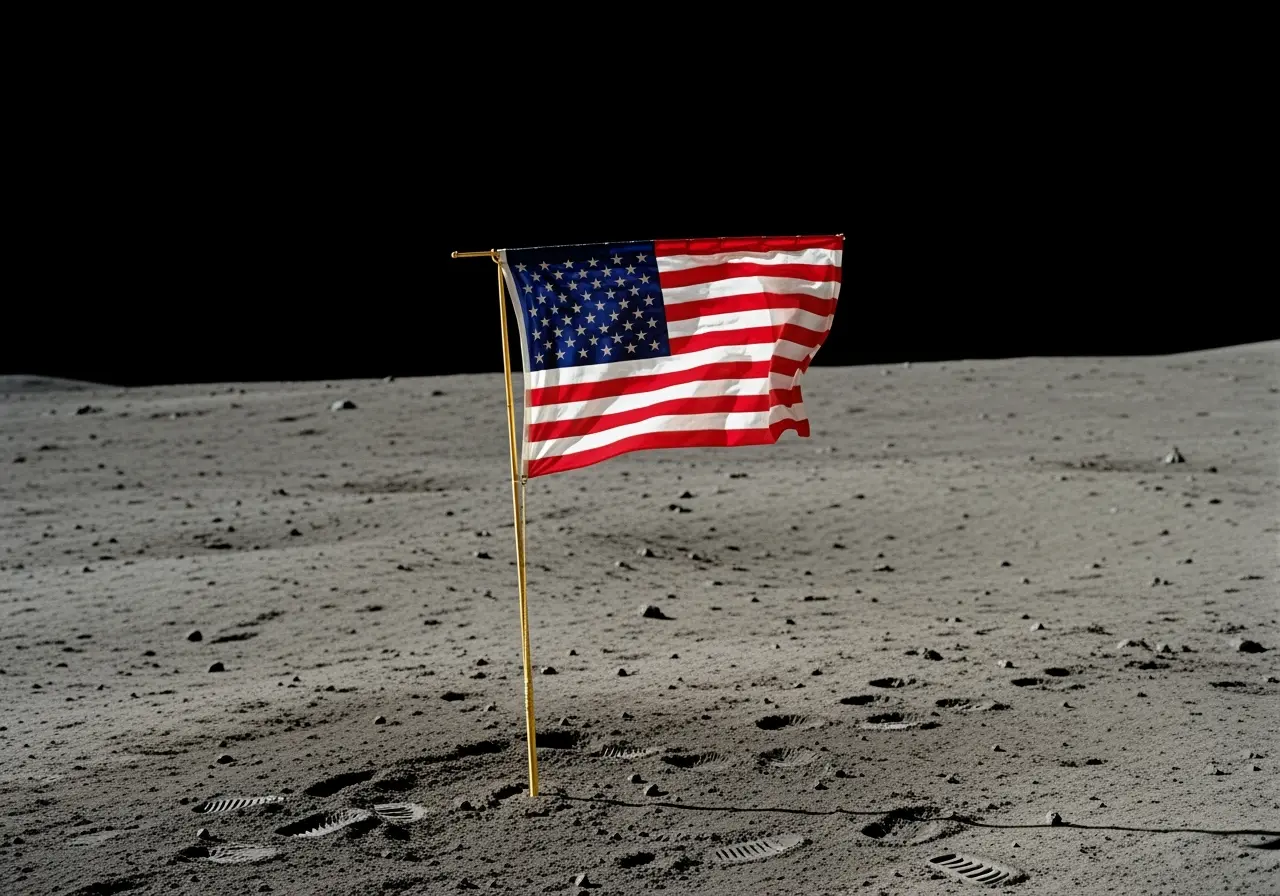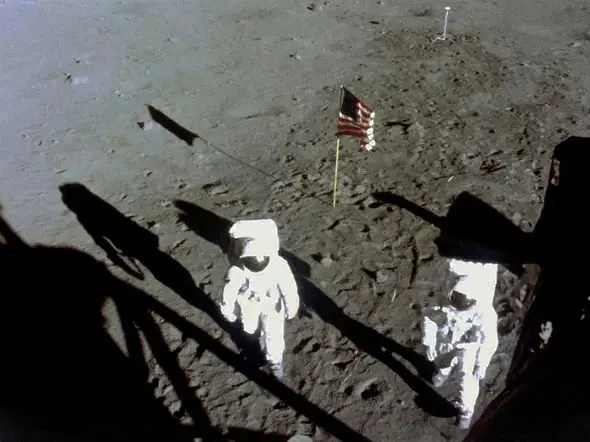July 20, 1969. 4:17 PM EDT. As Neil Armstrong stepped onto the lunar surface and spoke those immortal words—"That's one small step for man, one giant leap for mankind"—millions of Americans watched in awe. But few knew that the flag about to be planted on the moon had been purchased just weeks earlier at a Sears store in Houston for $5.50.
This is the incredible story of how an ordinary nylon flag became the most famous banner in human history—and the engineering challenges that nearly prevented it from happening at all.
The Last-Minute Shopping Trip
In the frantic final weeks before Apollo 11's launch, NASA faced an unexpected problem: they had rockets, spacesuits, and computers worth billions of dollars, but they didn't have a flag. The oversight seems almost comical now, but flag placement wasn't originally part of the mission plan.
It was only after public pressure and congressional interest that NASA scrambled to add a flag ceremony to the lunar EVA (Extra-Vehicular Activity). With time running out, NASA contractors literally went to the nearest Sears store in Clear Lake, Texas, and bought a standard 3x5 foot nylon American flag off the shelf. The receipt showed $5.50—about $38 in today's money.
But this wasn't just any flag purchase. This piece of nylon would soon become the most photographed, most symbolic, and most technically challenging flag deployment in history.

The Engineering Nightmare
Here's what NASA's engineers quickly realized: flags don't work in space. On Earth, flags wave because of wind and gravity. The moon has neither. Without an atmosphere, a flag would simply hang limp against its pole like a wet towel—not exactly the inspiring image America wanted to project to the world.
The solution was brilliant in its simplicity. NASA engineers designed a special telescoping flagpole with a horizontal crossbar at the top. This L-shaped pole would hold the flag out perpendicular to the main staff, creating the appearance of a flag waving in a stiff breeze—even in the vacuum of space.
The engineering challenges were immense:
- The pole had to be lightweight enough for the weight-conscious spacecraft
- It had to be simple enough for astronauts to deploy while wearing bulky spacesuits with limited dexterity
- It had to withstand the temperature extremes of space (from -250°F in shadow to +250°F in sunlight)
- It had to be compact enough to fit in the Lunar Module's cramped storage compartments
The $75 Flagpole That Saved the Day
The final flagpole assembly cost $75 in materials—about $523 today. It consisted of two telescoping aluminum tubes with a horizontal crossbar and a mechanism that would allow the flag to be deployed with minimal effort. The entire assembly weighed just 9 pounds.
But there was a problem during testing: the horizontal bar kept jamming. Engineers worked around the clock to fix the mechanism, but on the morning of launch, they still weren't sure it would work properly on the moon.
The Moment of Truth
After Armstrong and Buzz Aldrin completed their scientific tasks on July 20, 1969, they turned to the flag ceremony. Armstrong carried the flag assembly about 25 feet from the Lunar Module and began the deployment process.
The main pole went into the lunar soil easily—too easily, in fact. The moon's surface was harder than expected, and they could only drive the pole about 8 inches deep. Both astronauts worried it might fall over, especially when the Lunar Module's engines fired for takeoff.
Then came the horizontal bar. As millions watched on live television, Aldrin struggled with the mechanism. The crossbar was partially jammed, just as engineers had feared. He managed to extend it about 90%, giving the flag a slight wrinkle that actually made it look more natural—as if it were rippling in a breeze that didn't exist.

The $5.50 Flag's Finest Hour
The moment Armstrong and Aldrin stepped back and saluted the flag, that $5.50 piece of nylon became priceless. The image of the American flag on the moon—stiff, bright, and defiant against the black lunar sky—became one of the most iconic photographs in human history.
President Nixon called it "the proudest moment in American history." The Soviet Union, which had been leading the space race, fell silent. Around the world, people understood they were witnessing something unprecedented: humans had not only reached another world, but they had claimed it in the name of peaceful exploration.
The Technical Triumph
What made this moment even more remarkable was the engineering precision required. The flag had to be positioned perfectly for the television cameras. The astronauts had practiced the deployment countless times on Earth, but the moon's one-sixth gravity made everything feel different.
The flag's nylon material was specifically chosen because it was lightweight and would photograph well against the lunar landscape. The red, white, and blue colors were vibrant and would show up clearly in both the black-and-white television broadcast and the color photographs.
The Unintended Consequences
What NASA didn't anticipate was what would happen to their $5.50 flag over the following decades. The moon has no atmosphere to filter the sun's ultraviolet radiation. For over 50 years, that flag has been bombarded by unfiltered solar radiation 24/7 during the lunar day.
Scientists now believe the Apollo 11 flag—along with the five other flags planted by subsequent Apollo missions—has been completely bleached white. The red and blue have been stripped away by radiation, leaving only a ghostly white banner on the lunar surface.
In a poetic twist, the flag that once symbolized American achievement in living color now stands as a white flag of peaceful exploration—perhaps more fitting for a mission that came "in peace for all mankind."

The Flag That Fell
There's one more detail that adds human drama to this story. As Armstrong and Aldrin prepared to leave the moon, Aldrin looked out the Lunar Module window and watched their flag during engine ignition. The exhaust from their rocket engine knocked the flag over.
"The flag is down," Aldrin reported matter-of-factly. That $5.50 flag, which had stood proudly for 21 hours and 36 minutes, was blown over by the very rocket that was taking its planters home.
But the image had already been captured. The photograph of Armstrong and Aldrin saluting the flag had already traveled 240,000 miles back to Earth and into the hearts of people everywhere.
The Legacy of Six Flags
Apollo 11 was just the beginning. Five more Apollo missions would plant flags on the moon:
- Apollo 12: Pete Conrad and Alan Bean, Ocean of Storms
- Apollo 14: Alan Shepard and Edgar Mitchell, Fra Mauro Highlands
- Apollo 15: David Scott and James Irwin, Hadley-Apennine
- Apollo 16: John Young and Charles Duke, Descartes Highlands
- Apollo 17: Eugene Cernan and Harrison Schmitt, Taurus-Littrow Valley
Each flag was purchased from the same government supply catalog for $5.50. Each faced the same engineering challenges. Each became a symbol of human achievement.
The Modern Space Flag Challenge
Today, as private companies like SpaceX prepare for new lunar missions and eventual Mars exploration, flag engineering has become even more sophisticated. Modern space flags must withstand not just radiation and temperature extremes, but also the unique challenges of different planetary environments.
NASA is developing new flag materials that can resist radiation bleaching and maintain their colors for decades. Future Mars flags will need to withstand dust storms and a thin but corrosive atmosphere.
What We Can Learn Today
The story of the Apollo 11 flag teaches us several important lessons about flags and engineering:
- Simplicity Works: The most complex space mission in history succeeded with a $5.50 flag and a $75 pole
- Preparation Matters: Even simple tasks become complex in extreme environments
- Symbolism Transcends Materials: The flag's value wasn't in its cost, but in what it represented
- Innovation Solves Problems: When there's no wind, you engineer your own
- Quality Endures: That nylon flag lasted exactly as long as it needed to for its mission
From a $5.50 Flag to the Stars: Humanity’s Continuing Mission
As humanity prepares for return missions to the Moon and eventual journeys to Mars, the lessons from the first flag on the lunar surface continue to inspire engineers facing challenges of materials and deployment in space. At Baldwin Flag Company, we believe every flag tells a story—whether over a home, a business, or someday a Martian base, it stands for quality, engineering, and meaning. The $5.50 Sears flag that made history proves extraordinary achievements can start with ordinary materials, and its planting marked not just America’s success but humanity’s first steps into the cosmos. Though bleached by solar radiation, that flag still endures on the Moon as a symbol of courage and ingenuity, reminding us that wherever humans go, we carry our symbols and our determination to explore. From a humble nylon banner to the stars—that spirit defines our continuing mission.

Order Your U.S. Flag Today!
Want to fly the Stars and Stripes at your home, business, or event? There’s no better way to honor America and all it represents than with a flag built to last. Our U.S. flags are Veteran-Owned, Made in the USA, and Weather-Tested to stand strong in any season. Looking for something unique? We also create custom flags and banners so you can showcase your pride, your brand, or your cause with the same quality and craftsmanship.
The $5.50 Flag That Made History: America’s Space Adventure